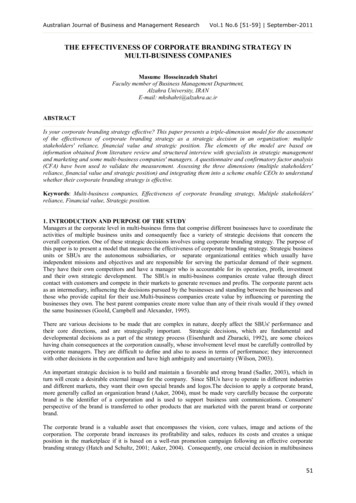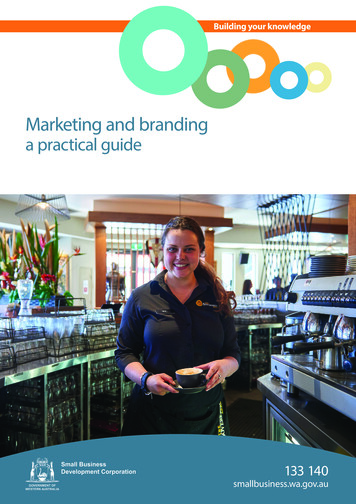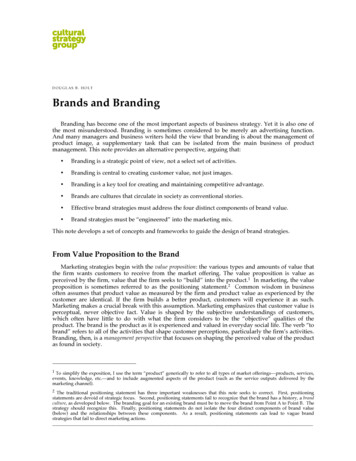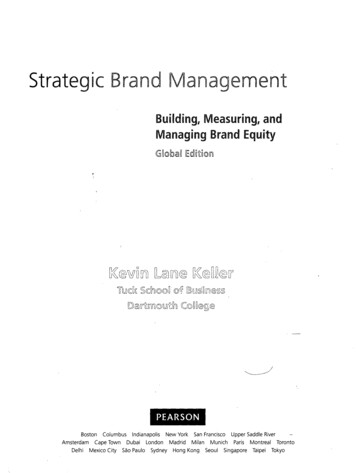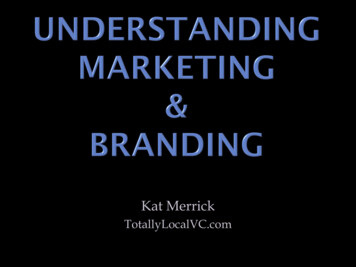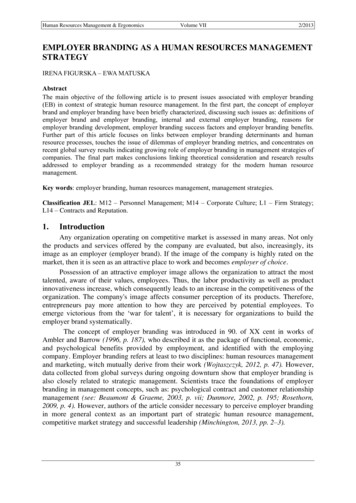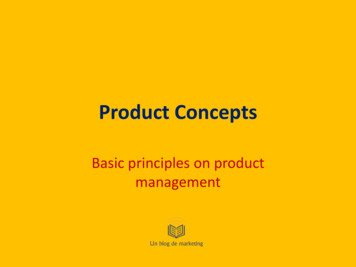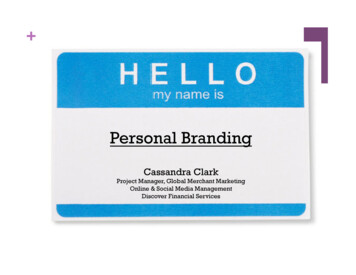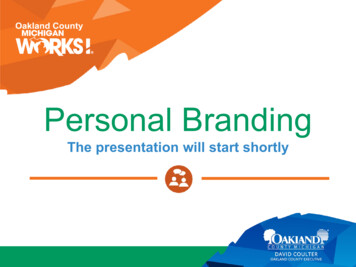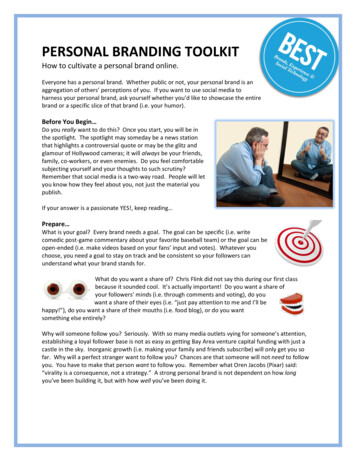
Transcription
PERSONAL BRANDING TOOLKITHow to cultivate a personal brand online.Everyone has a personal brand. Whether public or not, your personal brand is anaggregation of others’ perceptions of you. If you want to use social media toharness your personal brand, ask yourself whether you’d like to showcase the entirebrand or a specific slice of that brand (i.e. your humor).Before You Begin Do you really want to do this? Once you start, you will be inthe spotlight. The spotlight may someday be a news stationthat highlights a controversial quote or may be the glitz andglamour of Hollywood cameras; it will always be your friends,family, co-workers, or even enemies. Do you feel comfortablesubjecting yourself and your thoughts to such scrutiny?Remember that social media is a two-way road. People will letyou know how they feel about you, not just the material youpublish.If your answer is a passionate YES!, keep reading Prepare What is your goal? Every brand needs a goal. The goal can be specific (i.e. writecomedic post-game commentary about your favorite baseball team) or the goal can beopen-ended (i.e. make videos based on your fans’ input and votes). Whatever youchoose, you need a goal to stay on track and be consistent so your followers canunderstand what your brand stands for.What do you want a share of? Chris Flink did not say this during our first classbecause it sounded cool. It’s actually important! Do you want a share ofyour followers’ minds (i.e. through comments and voting), do youwant a share of their eyes (i.e. “just pay attention to me and I’ll behappy!”), do you want a share of their mouths (i.e. food blog), or do you wantsomething else entirely?Why will someone follow you? Seriously. With so many media outlets vying for someone’s attention,establishing a loyal follower base is not as easy as getting Bay Area venture capital funding with just acastle in the sky. Inorganic growth (i.e. making your family and friends subscribe) will only get you sofar. Why will a perfect stranger want to follow you? Chances are that someone will not need to followyou. You have to make that person want to follow you. Remember what Oren Jacobs (Pixar) said:“virality is a consequence, not a strategy.” A strong personal brand is not dependent on how longyou’ve been building it, but with how well you’ve been doing it.
Launch Which channels will you use to distribute your brand? Here are a few thoughts to keep in mind: Home base: most brands have a central node. The central node can be WordPress, Blogger,Facebook, or anything else. A central node keeps track of all informationrelated to your brand, including an “About” section that, at a minimum, tellspotential followers who you are. All information posted on non-central sitesfeeds back to the home base. For example, you create an online personality onYouTube and post those videos on Facebook. YouTube is your home base, and,ideally, you embed YouTube links to your Facebook feed. All views onFacebook are relayed back to YouTube so you can track total views from onelocation. Where should you launch? Below is a list of potential outlets. Choose the ones that appeal toyou, your goal, and, importantly, your followers.o Bloggero Facebooko Podcasto Twittero WordPresso YouTubeo Email – Send a regular email to subscribers. Chances are that you subscribe to at leastone email distribution right now. What do you like about it? What don’t you like aboutit? Benefit: you have more control over your brand. There is no reply-all or commentingsection for subscribers to share their thoughts with everyone. Subscribers only sharetheir thoughts with you. Drawback: subscriber growth may be more difficult over email.o FigDig – Free online portfolios for those with some artistic flare.o Carbonmade – Free online portfolios for those with some artistic flare.Remember, that your audience may not prefer one form of communication or may not even beregistered on websites such as Facebook. If you like to write creative nonfiction pieces for people whoare 65 years old or anything for children under 13 years old, email or blogs may be a better option thanFacebook. (Note: Facebook users must be at least 13 years old to register.)Look at your competition. Is there someone with a similar brand already? The brandcan be similar in terms of content or another metric. What is that person doing? Arethere any best practices that you can adopt?
Content Remember what the zany guy at OraBrush said? What are the “4 C’s”? Here is our take on his 4 C’s.ContentBalance substance with style. Remember the engagement arc.Tell a story. Remember what Oren Jacobs (Pixar) said. People remember stories, nota list of facts. Something becomes a story when there is a struggle, a decision, and asubsequent action that advances the plot. You cannot go back after the action.Create two-way communication. Content does not end with your last sentence. It iscontinuous and includes communication from your followers.Running out of ideas for content? Ask your followers what they’d like to see or hear. People lovesharing their opinions and will feel more attached to your brand, even if you don’t go with someone’sspecific suggestion. Or have a guest post an article, video, etc.Have an easy-to-find “About” section on your site to help potential followers understand who you areand why you’re brand exists. Include a mini-bio at the end of each post if your brand will appear onother sites.Call to ActionBe specific. Tell people what you’d like them to do. Don’t leave themguessing. Remember OraBrush? Every video told viewers to “leave acomment below” and “subscribe by clicking the button above.”CollaborationEngage your users. Easy and effective tactic: thank people – subscribers, people who comment,guests, etc. You want people to feel like they are a part of your brand. Respond to followers’comments and communications. You will gain their trust and learn a lot about them and howyour brand is perceived. Remember, people connect with people, not websites, blogs, or videos.ConsistencyYour brand should have a consistent theme. This theme will resonate with yourfollowers and keep them coming back even when there are no incentives. However,you will not earn repeat business by simply meeting expectations. Every post needsto innovate around your theme and go beyond expectations.
Analyze A critical component to building your online personal brand is collectingdata and understanding that data. Unlike traditional media, informationand flow of information can be measured and understood without mucheffort or cost. Here are some ways to measure and understand yourpersonal brand: Survey followers to find out more about them. You will learnwho they are and why they are following you. Something assimple as “vote if you like cake” tells you more about your users. Facebook Page: Facebook offers free tools to monitor weeklytraffic to and from a Facebook page that you create. Google Analytics: Feature rich tools that help you understandyour personal brand. Klout: Measures the online influence of your Facebook orTwitter profile. Alexa.com/siteinfo: Ranks websites and tells you informationabout site visitors (location, search engine queries, etc). Note: this will only work if you have aregistered domain (i.e. www.jenniferspersonalbrand.com). It will not work if you have a subdomain (i.e. www.facebook.com/jenniferspersonalbrand). Compete.com: Measures daily uniques to your site and gives information about your visitors(age, location, etc). Note: this will only work if you have a registered domain (i.e.www.jenniferspersonalbrand.com). It will not work if you have a sub-domain (i.e.www.facebook.com/jenniferspersonalbrand). Google Adwords Keyword Tool: Tells you how many times people search for a keyword everymonth. This can be useful if you’d like to drive organic growth through search ToolExternal or Google “adwords targetingkeyword ideas”)Need more? There are several additional services out there that can help you understand your personalbrand and its effectiveness. Try a quick Google search to find additional services.
Grow Your most powerful marketing tool is your current followers. Encourage your followers to tell theirfriends about your brand if they like what you’re doing.Make it very easy to comment or subscribe. People do not want to search for subscription button. Ifyou use Blogger or Wordpress, you can add an opt-in button to yourFacebook page. Also, create specific links to understand how users aregetting to you. Are they coming from Facebook or are they coming fromanother blogger?Get someone’s contact info and add them to your blog, email chain,Facebook Page, etc. Many people forget to follow up and subscribe after aninitial conversation. Help them by taking care of the final step.Experiment with how to grow subscriber base and target strategies thatwork. Examples include: ContestsGiveawaysCommentsLikes (a favorite of Avinash Kaushik)Swap PR with other bloggers or sitesWrite-ups in magazinesCelebrity/node endorsementsAdvertiseTurn This Into A Business Do you want to earn income from your personal brand? Similar to “BeforeYou Begin ,” ask yourself “is it worth it?” Will you lose the trust of yourfollowers? Will you have to change your brand?Advertisements. A common form of earning income from your personalbrand is hosting advertisements. A typical business earns 0.20- 0.40 perfollower per month for advertisements. Again, ask yourself if advertisingwill not create conflicts with your personal brand.
PERSONAL BRANDING TOOLKIT How to cultivate a personal brand online. Everyone has a personal brand. Whether public or not, your personal brand is an aggregation of others’ perceptions of you. If you want to use social media to harness your personal bran
